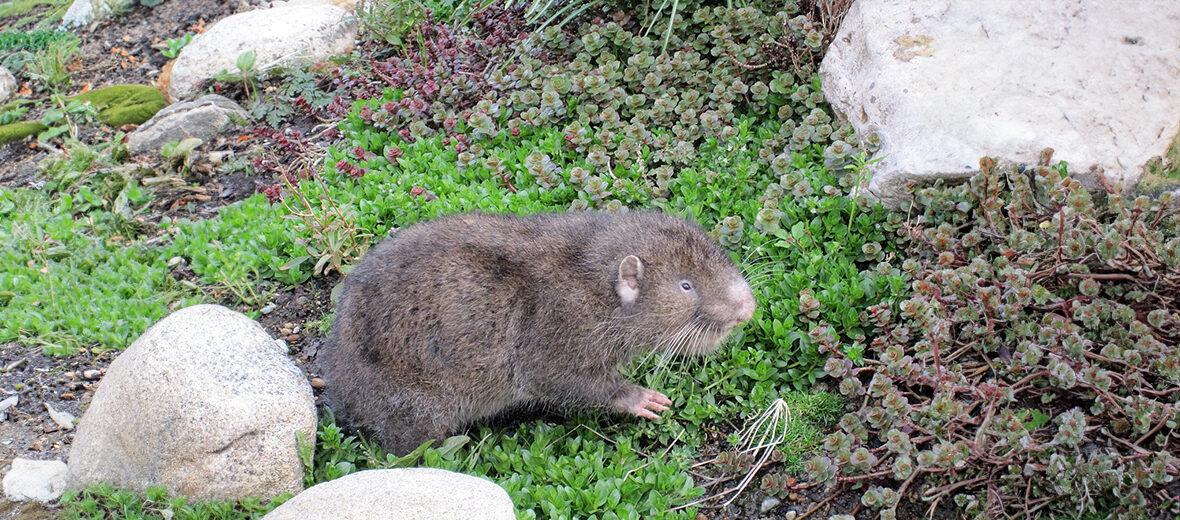
The mountain beaver is sometimes confused with the North American beaver and the Eurasian beaver, however, these beavers are more closely related to squirrels. Although they are mostly considered pests throughout their ranges, they are still threatened by wildfires, grazing livestock, expansion of exotic plant species, rodent control methods, alteration of natural stream flow, housing developments, highway construction, & predation by cats and dogs. However, these rodents are still abundant and have stable populations throughout most of their ranges. They are therefor listed as Least Concern by the IUCN.
First the Stats…
Scientific name: Aplodontia rufa
Weight: Up to 2 lbs.
Length: Up to 20 inches, plus up to a 1.57 inch tail
Lifespan: Up to 10 years
Now on to the Facts!
1.) These critters are considered the smallest beaver species, but again are more closely related to squirrels than to beavers.
2.) These critters can be found in British Columbia, Canada; Washington, Oregon, California, and Nevada, in the United States.
3.) There are 7 subspecies of mountain beavers, 6 are found in California and 3 of those are endemic to that state.
4.) Mountain beavers are considered to be living fossils. This is due to the presence of a host of primitive characteristics, primarily the protrogomorphous zygomasseteric system. This is the anatomical arrangement of the masseter muscle of the jaw and the zygomatic arch of the skull.
5.) According to fossil records, the Aplodontiidae split from squirrels in the Middle to Late Eocene as shown by the extinct genera Spurimus and Prosciurus.
But wait, there’s more on the mountain beaver!
6.) Their initial similarity with true beavers is related only to their relatively large size, strong aroma, propensity for living in very watery or moist habitats, and their habit of gnawing on bark and cutting branches.
7.) Mountain beavers don’t fell trees, build dams, live in lodges/dens, or communicate via slapping their tails, considering their tails are tiny.
Did you know…?
The name Aplodontia, which translates to “simple tooth” is in reference to the single large basin housing the bulk of each cheek tooth. The specific epithet, rufa, translates to “red” or “reddish”.
8.) They are both nocturnal (active at night) and crepuscular (active at both dawn and dusk).
9.) These critters have been known to climb trees several feet up to access food in the form of branches and leaves. Other than that, their diet mostly consists of ferns. Some of these fern species are toxic to other animals. They also engage in coprophagy (eating their own fecal “poop” pellets).
10.) Due to their inability to concentrate urine it is necessary to drink large amounts of water daily.
But wait, there’s still more on the mountain beaver!
11.) They possess slightly opposable thumbs and they often sit on their hindquarters and position food with their forelimbs and incisors.
12.) Mountain beavers are typically solitary and don’t often share burrows.
Did you know…?
Among the many parasites of the mountain beaver is the largest flea known (Hystrichopsylla schefferi). The females of this flea species can measure up to a whopping 0.31 inches long! That’s as thick as a standard grain of rice.
13.) The entrances to their burrows usually have clumps of wilted vegetation that they most likely use as a type of food cache as well as a collection of nesting material.
14.) Some predators that their burrows aid in protecting them from are bobcats, coyotes, cougars, owls, golden eagles, skunks, and weasels.
15.) These beavers are considered pests in many areas of the Pacific Northwest due to the extensive damage they can cause to forest trees because of their basal-grinding (removal of bark), branch cutting, and/or clipping of small saplings and seedlings.
But wait, there’s still a little more on the mountain beaver!
16.) Damage control measures executed by the forestry service in order to protect forest trees include trapping, placing toxic baits, exterminating, and constructing physical barriers (e.g., plastic mesh tubes) around the base of individual trees.
17.) Females undergo up to a 1 month gestation (pregnancy) that yields up to 3 kits.
18.) Kits are weaned in up to 8 weeks and leave the safety of their burrow shortly after.
Now a Short Mountain Beaver Video!
Be sure to share & comment below! Also, check out the Critter Science YouTube channel. Videos added regularly!
Want to suggest a critter for me to write about? Let me know here.
Some source material acquired from: Wikipedia & IUCN
Photo credit: Kathleen Dobson




